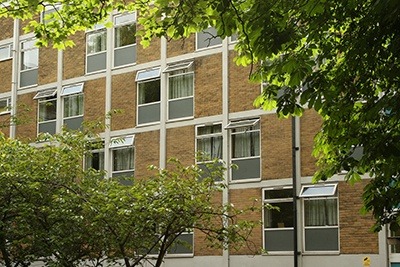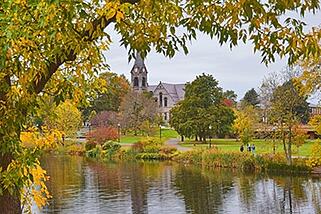Colleges and universities are facing rising costs, decreasing funding, and aging infrastructure, all of which are resulting in a fierce arms race for colleges and universities to attract students. For students that means higher costs, and for many colleges, that means more debt incurred through their efforts of trying to “keep up.”
As most college and university leaders know, in many cases those investments have been spent on luxurious amenities like lazy rivers and rock-climbing walls. High Point University in North Carolina incorporated hot tubs, free movie theaters, and arcades into campus life. More students applied for admission, which led to a more than 20 percent decrease in admittance between 2002 and 2012. But for other campuses, the investment can backfire. For example, even after Indiana University of Pennsylvania invested $270 million to replace all campus housing with apartment-style suites, the enrollment rate dropped 17 percent from 2010 to 2016.
It’s easy for universities and colleges to get pulled into this amenities race and lose sight of the challenges: rising cost of education, aging facilities, and reduced funding. Before you start writing checks for your next campus housing project, take these questions into account to make sure the project meets the needs of your school and gives your university the most value for its investment.
What is your university’s vision and mission, and does this campus housing project align with it?
It seems simple but is often overlooked — tie each project to your mission. Each institution has its own vision and mission, and ideally the physical campus and the campus experience are designed to support them.
Residential life is a key aspect of the campus experience, and everything from housing type to location to amenities can make a difference. For example, if your vision includes residential and online students from around the world working together, maybe your residence hall needs some study space with the latest electronic collaboration equipment. And if your mission is to go beyond academics and develop the whole student, maybe your residence hall includes wellness features such as fitness space and healthy food options.
What can you do? Step back and ask yourself what kind of student housing will help your institution achieve its vision and mission.
What’s the total lifecycle cost, not just first cost, of the project?
Across the country, we hear stories of facilities that are grappling with operations and maintenance expenses, including costs from deferred maintenance on campuses. Many campuses are struggling to maintain aging infrastructure, and adequate money for maintenance is either not in the budget or is being diverted to building new facilities.
There are many examples of facilities spending money on emergency repairs instead of investing in a good maintenance program, which would help them reduce unpredictable and expensive maintenance emergencies. Why then are the initial expenditures for design and construction, or first costs, often the only budgets considered? After all, more buildings are going to lead to even more maintenance. It’s a case of carpe diem – if you can get your hands on money for a new building, spend it now before you lose it.
With fluctuations in policy and funding, it can be challenging to plan for long-term costs. Public colleges and universities are tied to civic policy and state budgets, which are subject to the ever-changing political environment. Private colleges and universities face similar challenges, especially with donor dollars directed to building the shiny new building, rather than maintaining it.
Some institutions leaders that are considering lifecycle costs are also considering alternate forms of project delivery. This includes public-private partnerships (P3), which forces universities to look at the entire lifecycle cost of a project when making business decisions. For example, when the University of California, Merced, established the ambitious goal to double its student body by 2020, the campus used a P3 approach to design, build, partially finance, operate, and maintain the campus. The contract included the 39-year lifecycle of the buildings and gave the university the opportunity to focus on what mattered most to them: academics and student success.
What do your students really want?
Tuition and fees at public four-year institutions grew more than 60 percent over the past 10 years, according to the College Board. Superfluous campus projects are often paid for via student fees, like the lazy river at Louisiana State University, which resulted in a 20 percent increase in student fees.

With total burden of student debt increasing, universities are feeling pressure to justify the value of a college education. The student housing value proposition must consider what items have the biggest influence on the academic success for the student. When universities ask students to spend more for housing, which directly impacts debt, the students are asking what they will gain in return. And this is where the amenities arms race is starting to get pushback from the students themselves.
“Every generation is shaped by the events that compose their formative years. The new crop of college students, dubbed Generation Z, lived through the great recession. They saw parents lose jobs and even siblings move home after college. The result is a generation that is increasingly competitive for opportunities. They truly value a college education and the doors it may open. However, they are also cost-conscious and debt adverse. They seek amenities that contribute to their scholarly pursuits, but also look for value. The challenge for housing officers is going to be striking that balance,” said Jay Pearlman, Senior Vice President for Advisory Services at The Scion Group, a firm with expertise in all phases of planning, implementing and operating student housing.
For large universities that have student bodies with a wide array of interests and needs, offering different housing options can give more students the college experience they want. The University of Washington, for example, has a tiered housing system. The newer residence halls, which have more amenities, charge more for room and board. This approach builds in choices for students to balance their housing costs along with other costs.
Georgia State University tried a similar approach in 2009. “We built the least expensive rooms we could come up with,” said Tim Renick, Georgia State’s vice president for enrollment management and student success, in a Washington Post article last year. Since it was built, the freshman dorm is one of the more popular housing options on campus as students can get a room and a meal plan for the same price as an apartment-like residence. At the University of San Francisco, where they’re operating in a city faced with housing shortages and sky-rocketing real estate prices, the campus is cutting square footage per bed by a third.
What’s the best way to know what your students really want? It’s easier than you think – ask them. Give student representatives a seat at the table when planning a new campus project. If you’re going to send out a survey to the student body, make sure you consider the lifecycle cost on investments, not just the first cost, and how it’s going to impact the price of their education.
Case in point: UMass Boston
University of Massachusetts Boston is a great example of a university that has taken these three questions into consideration. In 2006, the university leadership organized a Master Plan Steering Committee comprised of faculty, students, and staff to recommend a framework for campus development and reconstruction. With its vision in mind – to be a student-centered, urban public research university educating modest-income and first-generation students from urban areas – the committee collaboratively developed a 25-Year Campus Master Plan.

To deliver on its vision to become student-centered, included in the master plan was to add student housing to the campus for the first time. This was a transformation for the university as it had historically been a commuter school. The student housing initiative came after several other capital improvement investments, which left UMass strapped for cash. The campus turned to private developers to build the needed student housing. This allowed student housing to be built on campus, with risk, cost, and profit in the hands of a private developer. The result? A state of the art, yet practical, residence hall.
What you can do
Before you consider luxury amenities that will drive up costs and increase student debt, revisit your university’s mission and values, calculate the lifecycle costs of the project, and make sure to ask if it’s what the student really wants. Not only will it save your campus and students a lot of money, everyone’s needs will be met.
Published: 9/4/2018




